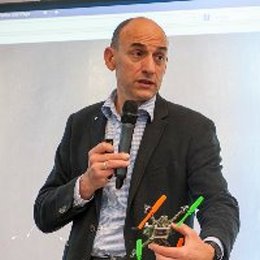The first robotic birds, like the Robird® that was developed at the University of Twente, are flying and operational right now. Still, taking off and landing like a bird or asymmetric wing flapping are not possible yet. Sharing Leonardo da Vinci’s dream, Professor Stefano Stramigioli wants to develop a new theory on flapping flight, leading to the next generation of robotic birds. For this, he received an Advanced Grant of the European Research Council, worth 2.8 million euros.
The ease with which birds are flying, made Leonardo da Vinci dream of machines that could do the same, already in the 15th century. Airplanes, with their fixed wings, work well but this is a watered-down version of the real thing: flapping flight. Mimicking the movements of bird’s wings, taking the complex air flow into account, is a different story. The Robird®, developed in Stramigioli’s group, is a major step forward. This is a robotic falcon that is commercially available through the spin-off company Clear Flight Solutions. It already won the European Technology Transfer Award.
In his new research project, Stramigioli wants to go much further: “We still don’t understand the 3D flow dynamics well enough. How to control this dynamics and design robots that can deal with it, is the next step. What we can’t do yet, is taking off and landing like a bird does, flying with asymmetrically flapping wings or automatically adapt to flow.”
Theory and wind tunnel tests
The development of the next generation of robotic birds starts with new theoretical insights. Stramigioli wants to use the so-called port-Hamiltonian system theory for this: it offers a powerful way of combining several physics domains and control theory, needed for describing what happens at the wing surface, for example. Based on the new insights, Stramigioli wants to test wing parts in the wind tunnel. The ultimate goal of his five year project is a new robotic bird.
Multidisciplinary team
For making this dream come true, Stefano Stramigioli set up a multidisciplinary team, including Prof Kees Venner (Engineering Fluid Dynamics), Prof Arjen van der Schaft (University of Groningen, port-Hamiltonian system theory), Prof Dannis Brouwer (mechanics of flexible systems), Prof Hans Zwart (infinite dimensional systems) and Prof Gijs Krijnen (bio-inspired sensors and actuators).
For his project ‘PORTWINGS – Decoding the Nature of Flapping Flight by port-Hamiltonian System Theory’, Stefano Stramigioli now receives an ERC Advanced Grant. In this round (press release), 269 senior researchers across Europe receive a total sum of 653 million euros.






